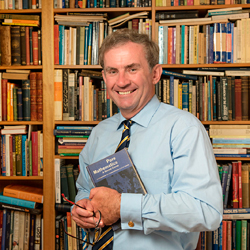Cathode Rays
/Here are some points about the nature of cathode rays for HSC Physics.
- Cathode rays (now called electrons) are small negatively charged particles leaving the cathode and attracted to the anode in a discharge tube containing air at a low pressure when a high voltage is applied between the electrodes.
- German scientists believed that cathode rays were a wave-like disturbance in the aether like light. Heinrich Hertz found that cathode rays could pass through thin sheets of gold and were not deflected by electric fields. Hertz left too much gas in his tube causing it to be ionised and so a weak resultant electric field existed between his deflecting plates....too weak to produce a noticeable deflection of the cathode ray beam.
- J.J. Thomson in 1897 used a lower pressure in his discharge tube and delected a beam of cathode rays towards the positively charged plate showing that cathode rays are negatively charged particles. Thomson applied a magnetic field perpendicular to his deflecting electric field using a set up known as Helmholtz coils. The magnetic field deflected the beam perpendicular to its velocity and by adjusting the strength of the field he was able to allow the cathode rays to pass through both fields in a straight line, the electric force balancing the magnetic force. In this case v = E/B, where v is the speed of the cathode ray, E is the strength of the electric field and B is the strength of the magnetic field.
- Thomson switched off the magnetic field and allowed the cathode rays to be deflected only by the electric field. He measured the angle 𝜽 at which the beam was deflected when it left the electric field; tan𝜽 = qEL/(mv 2 ), where L is the length of the electric field, v is the speed of the cathode ray and q/m is the charge to mass ratio of the cathode ray. If the sideways deflection y of the beam is measured instead of 𝜽 the equation connecting y and q/m is y = qB 2 L 2 /(2mE)
- Thomson found that the charge to mass ratio of cathode rays was a large number and was independent of the type of metal in the cathode. He concluded that cathode rays are small negatively charged partices that are present in all matter. His work established the existence of the electron as a fundamental particle of matter provided the basis for further advances in Physics such as quantum theory, semiconductor technology and superconductivity.
Some facts about cathode rays.
- The first observation of the presence of cathode rays was made by Julius Plucker in 1858 who noticed a green fluorescence coming from the wall of the glass tube near the anode. This colour is determined by the chemical composition of the glass.
- When a small paddle-wheel balanced on a pair of horizontal rails is placed in a discharge tube the vane always turns away from the cathode. This led William Crookes to (incorrectly) conclude that cathode rays were particles with momentum. H Starke later showed that the rotation of the vane was due to the heating of only one side of the vane by the cathode rays. The gas next to the vane had an increased pressure and so the vane was pushed away from the cathode. Thomson showed that the momentum of the beam was not sufficient to produce the observed motion. The paddle wheel experiment shows that cathode rays have a heating effect rather than momentum.
